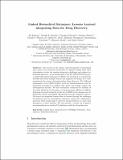| dc.contributor.author | Hasnain, Ali | |
| dc.contributor.author | Kamdar, Maulik | |
| dc.contributor.author | Deus, Helena | |
| dc.contributor.author | Mehdi, Muntazir | |
| dc.contributor.author | Decker, Stefan | |
| dc.date.accessioned | 2015-02-03T17:29:19Z | |
| dc.date.available | 2015-02-03T17:29:19Z | |
| dc.date.issued | 2014 | |
| dc.identifier.citation | Ali Hasnain, Maulik R. Kamdar, Panagiotis Hasapis, Dimitris Zeginis, Claude N. Warren, Jr, Helena F. Deus, Dimitrios Ntalaperas, Konstantinos Tarabanis, Muntazir Mehdi, and Stefan Decker (2014) Linked Biomedical Dataspace: Lessons Learned integrating Data for Drug Discovery International Semantic Web Conference 2014 | en_US |
| dc.identifier.isbn | 978-3-319-11963-2 | |
| dc.identifier.uri | http://hdl.handle.net/10379/4845 | |
| dc.description | Conference paper / Book chapter | en_US |
| dc.description.abstract | The increase in the volume and heterogeneity of biomedical data sources has motivated researchers to embrace Linked Data (LD) technologies to solve the ensuing integration challenges and enhance information discovery. As an integral part of the EU GRANATUM project, a Linked Biomedical Dataspace (LBDS) was developed to semantically interlink data from multiple sources and augment the design of in silico experiments for cancer chemoprevention drug discovery. The different components of the LBDS facilitate both the bioinformaticians and the biomedical researchers to publish, link, query and visually explore the heterogeneous datasets. We have extensively evaluated the usability of the entire platform. In this paper, we showcase three different workflows depicting real-world scenarios on the use of LBDS by the domain users to intuitively retrieve meaningful information from the integrated sources. We report the important lessons that we learned through the challenges encountered and our accumulated experience during the collaborative processes which would make it easier for LD practitioners to create such dataspaces in other domains. We also provide a concise set of generic recommendations to develop LD platforms useful for drug discovery. | en_US |
| dc.description.sponsorship | EU FP7 GRANATUM project,ref. FP7-ICT-2009-6-270139;
Science Foundation Ireland - Grants # SFI/12/RC/2289 and SFI/08/CE/I1380 (Lion 2) | en_US |
| dc.format | application/pdf | en_US |
| dc.language.iso | en | en_US |
| dc.publisher | Springer | en_US |
| dc.relation.ispartof | International Semantic Web Conference 2014 | en |
| dc.relation.ispartofseries | Lecture Notes in Computer Science;8796 | |
| dc.rights | Attribution-NonCommercial-NoDerivs 3.0 Ireland | |
| dc.rights.uri | https://creativecommons.org/licenses/by-nc-nd/3.0/ie/ | |
| dc.subject | Linked Data | en_US |
| dc.subject | Drug discovery | en_US |
| dc.subject | SPARQL Federation | en_US |
| dc.subject | Visualization | en_US |
| dc.subject | Biomedical research | en_US |
| dc.title | Linked Biomedical Dataspace: Lessons Learned integrating Data for Drug Discovery | en_US |
| dc.type | Conference Paper | en_US |
| dc.date.updated | 2015-01-27T18:21:51Z | |
| dc.local.publishedsource | http://dx.doi.org/10.1007/978-3-319-11964-9_8 | en_US |
| dc.description.peer-reviewed | non-peer-reviewed | |
| dc.contributor.funder | |~| | |
| dc.internal.rssid | 7914063 | |
| dc.local.contact | Syed Muhammad Ali Hasnain, Deri, Ida Business Park, Lower Dangan, Galway. Email: ali.hasnain@deri.org | |
| dc.local.copyrightchecked | Yes | |
| dc.local.version | ACCEPTED | |
| nui.item.downloads | 1963 | |


